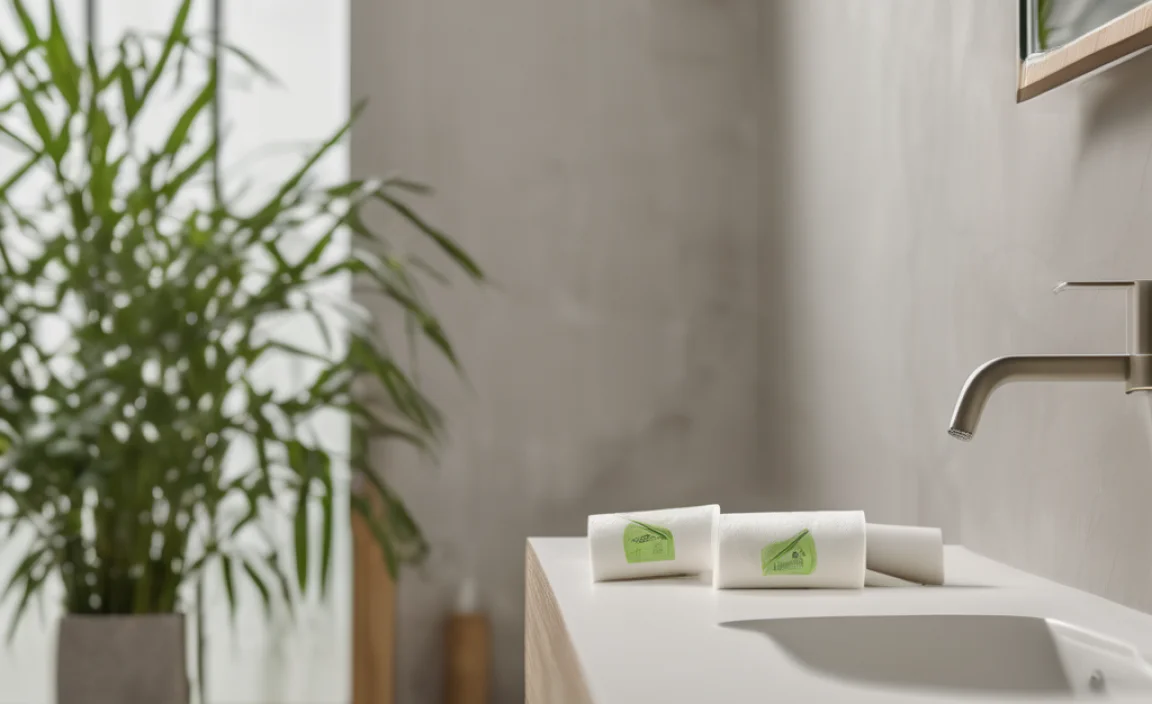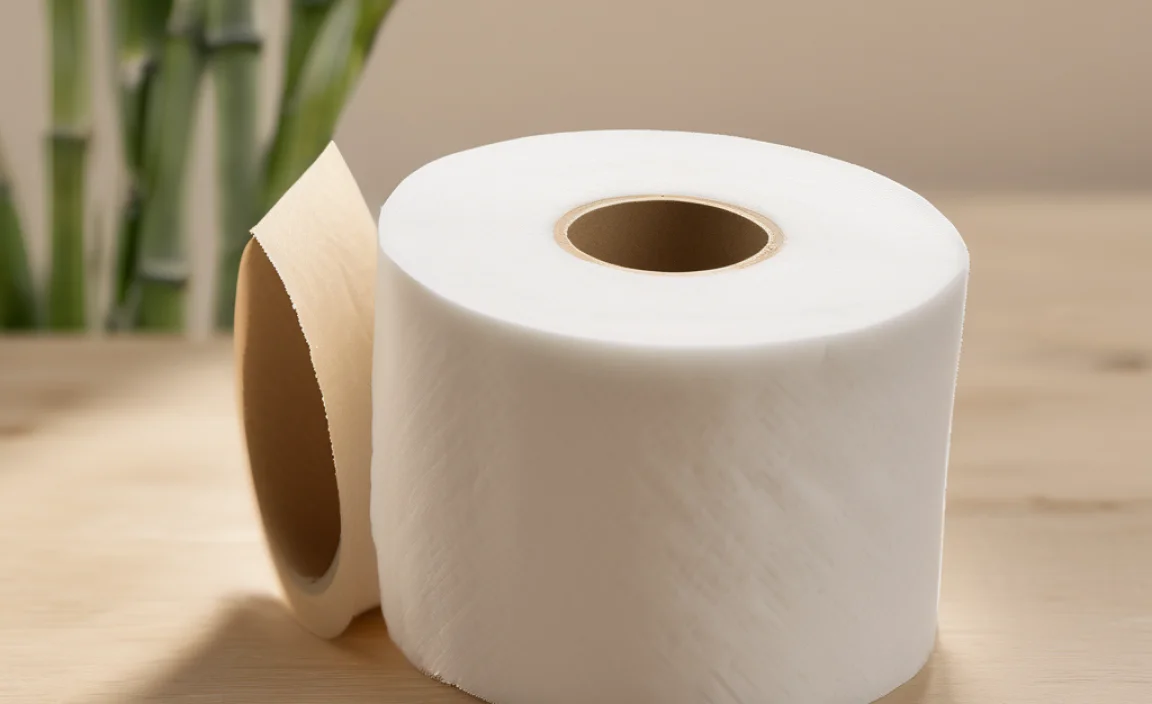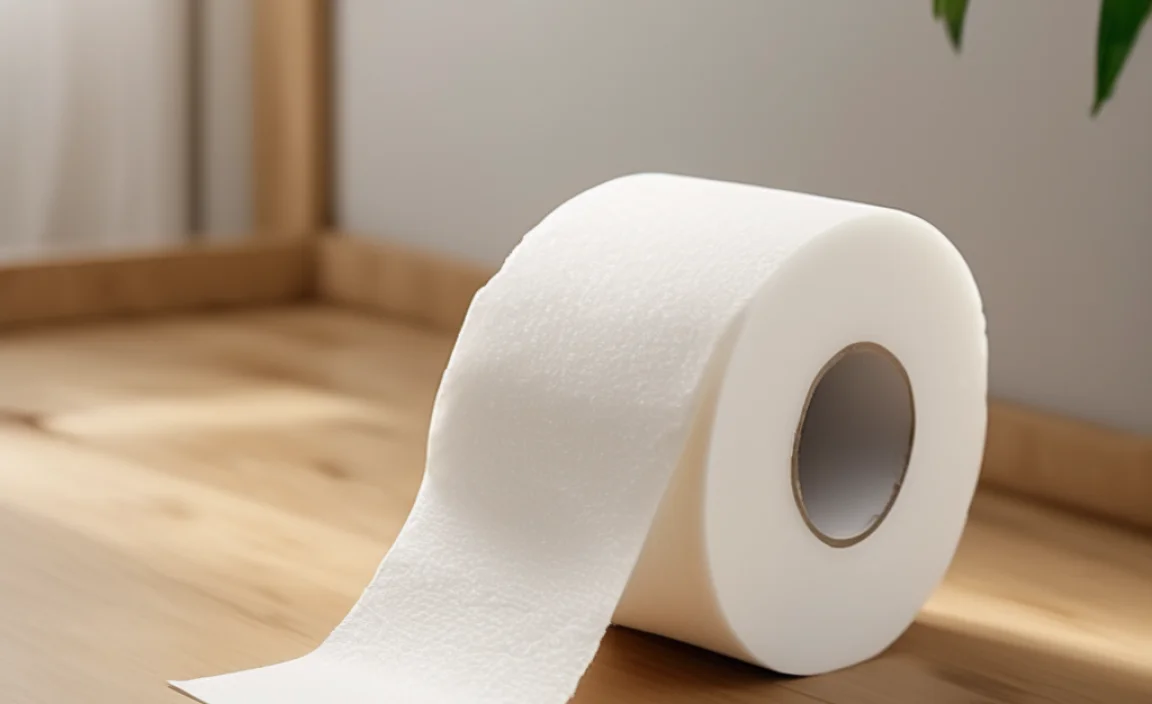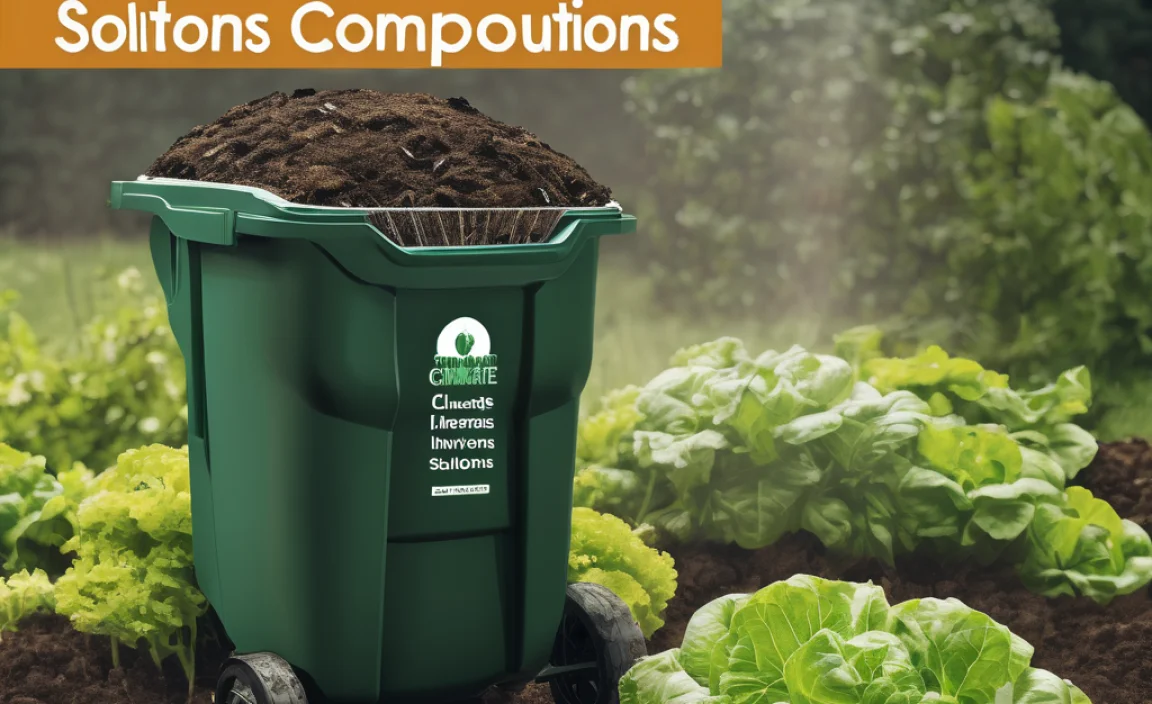Bamboo toilet paper is generally safe for most plumbing systems because it breaks down faster than traditional paper. However, like any toilet paper, using too much at once can cause clogs. To avoid problems, use only what you need, ensure your plumbing is in good condition, and consider flushing more frequently if you have older pipes.
Ever wondered if switching to bamboo toilet paper could cause plumbing problems? It’s a common worry! Nobody wants a blocked drain, and with so many toilet paper options out there, it’s hard to know what’s best for your pipes. You want to be eco-friendly without causing a plumbing nightmare.
In this guide, we’ll walk you through everything you need to know about bamboo toilet paper and your drains. We’ll cover how it compares to regular toilet paper, how to prevent clogs, and what to do if you already have one. Let’s get started and keep those pipes flowing smoothly!
Understanding Bamboo Toilet Paper

Bamboo toilet paper is becoming increasingly popular as an eco-friendly alternative to traditional toilet paper. But what exactly is it, and why are people making the switch?
What is Bamboo Toilet Paper?
Bamboo toilet paper is made from the fibers of the bamboo plant. Unlike traditional toilet paper, which comes from trees, bamboo is a highly renewable resource. It grows quickly and doesn’t require replanting after harvesting, making it a more sustainable choice. Many brands market it as a more environmentally friendly option for consumers looking to reduce their carbon footprint.
Benefits of Using Bamboo Toilet Paper
- Eco-Friendly: Bamboo grows rapidly and requires less water and pesticides than trees.
- Biodegradable: It breaks down more quickly than traditional paper, reducing the risk of clogs.
- Softness: Many users find bamboo toilet paper to be as soft, or even softer, than traditional options.
- Hypoallergenic: Bamboo is naturally hypoallergenic, making it a good choice for sensitive skin.
How Bamboo Toilet Paper is Made
The process of making bamboo toilet paper involves harvesting the bamboo, breaking it down into pulp, and then processing it into paper. Here’s a simplified overview:
- Harvesting: Bamboo stalks are cut and transported to a processing facility.
- Pulping: The bamboo is broken down into a pulp using mechanical and chemical processes.
- Cleaning and Bleaching: The pulp is cleaned and bleached to remove impurities and whiten the fibers. Some brands use chlorine-free bleaching methods.
- Paper Making: The pulp is spread out and dried into large sheets of paper.
- Converting: The paper is then cut, rolled, and packaged into the toilet paper rolls you see in stores.
Does Bamboo Toilet Paper Block Drains?

The big question: does bamboo toilet paper cause drain blockages? Let’s dive into the factors that influence whether or not bamboo toilet paper might clog your pipes.
Breakdown Rate Comparison
One of the key factors in whether toilet paper will clog your drains is how quickly it breaks down in water. Bamboo toilet paper generally breaks down faster than traditional toilet paper. This is because the fibers in bamboo are shorter and less dense than those in wood-based paper. When flushed, bamboo fibers separate more easily, reducing the likelihood of clumping and causing a blockage.
Several studies and tests have shown that bamboo toilet paper disintegrates more rapidly compared to conventional options. For example, a simple test involves placing equal amounts of different types of toilet paper in water and observing how quickly they dissolve. Bamboo toilet paper consistently breaks down into smaller pieces in a shorter amount of time.
Factors Influencing Drain Blockage
While bamboo toilet paper is designed to break down quickly, several factors can still contribute to drain blockages:
- Amount of Toilet Paper Used: Using excessive amounts of any type of toilet paper can overwhelm your plumbing system. Even fast-dissolving bamboo toilet paper can cause a clog if you use too much at once.
- Condition of Plumbing: Older pipes, especially those made of cast iron or clay, are more prone to clogs. These pipes can have rough interiors or narrow diameters that trap toilet paper and other debris.
- Water Flow: Low-flow toilets or inadequate water pressure can hinder the breakdown and flushing of toilet paper.
- Other Items Flushed: Flushing items other than toilet paper (such as wet wipes, feminine hygiene products, or cotton balls) can significantly increase the risk of clogs. These items don’t break down easily and can accumulate in your pipes, causing blockages.
Comparing Bamboo to Traditional Toilet Paper
Let’s take a closer look at how bamboo toilet paper stacks up against traditional toilet paper in terms of its impact on your drains:
| Feature | Bamboo Toilet Paper | Traditional Toilet Paper |
|---|---|---|
| Breakdown Rate | Faster | Slower |
| Fiber Density | Lower | Higher |
| Environmental Impact | Lower | Higher |
| Clog Risk (with proper use) | Lower | Moderate |
As the table shows, bamboo toilet paper generally has a lower risk of causing clogs due to its faster breakdown rate and lower fiber density. However, it’s still important to use it responsibly and avoid flushing excessive amounts.
How to Prevent Drain Blockages with Bamboo Toilet Paper

Even though bamboo toilet paper is less likely to cause blockages, it’s important to take preventive measures to keep your drains clear. Here are some practical tips to help you avoid plumbing problems.
Use Appropriate Amounts
One of the simplest ways to prevent clogs is to use only the necessary amount of toilet paper. Avoid using excessive amounts, even if it’s bamboo toilet paper. If you find yourself using a lot, consider flushing more frequently to prevent buildup in the pipes. It’s a simple habit that can save you from potential plumbing headaches.
Flush Regularly
Regular flushing helps keep the pipes clear and prevents the accumulation of toilet paper and other waste. Make it a habit to flush after each use, especially if you have a low-flow toilet. This ensures that everything moves smoothly through your plumbing system and reduces the risk of blockages.
Maintain Your Plumbing System
Regular maintenance of your plumbing system is crucial for preventing clogs. Here are some steps you can take:
- Regular Inspections: Have a plumber inspect your pipes periodically to identify potential problems like corrosion or blockages.
- Clean Drains: Use drain cleaners or natural solutions like baking soda and vinegar to clear minor buildup.
- Address Issues Promptly: Repair any leaks or plumbing issues as soon as they arise to prevent further damage and potential clogs.
Avoid Flushing Non-Flushable Items
One of the biggest causes of drain blockages is flushing items that aren’t meant to go down the toilet. These include:
- Wet Wipes: Even if they’re labeled as “flushable,” they often don’t break down properly and can cause major clogs.
- Feminine Hygiene Products: Tampons and pads should always be disposed of in the trash.
- Cotton Balls and Swabs: These don’t dissolve and can accumulate in your pipes.
- Diapers: Never flush diapers, as they will expand and cause severe blockages.
Make sure everyone in your household knows what can and cannot be flushed to prevent accidental clogs.
Consider a Toilet Paper Test
If you’re still concerned about whether your toilet paper is contributing to clogs, you can perform a simple test:
- Fill a Clear Container: Fill a clear container with water.
- Add Toilet Paper: Place a few sheets of the toilet paper in the water.
- Shake and Observe: Shake the container vigorously and observe how quickly the toilet paper breaks down.
If the toilet paper disintegrates quickly into small pieces, it’s likely to be safe for your plumbing. If it remains intact or forms large clumps, it may be more likely to cause clogs.
What to Do If You Have a Clog
Despite your best efforts, you might still encounter a clogged drain. Here’s how to tackle it.
Common Signs of a Clogged Drain
Recognizing the signs of a clogged drain early can help you address the problem before it becomes severe. Some common signs include:
- Slow Draining: Water drains slowly from the toilet bowl.
- Gurgling Sounds: Unusual gurgling sounds coming from the toilet or nearby drains.
- Water Backup: Water backing up into the toilet bowl or overflowing.
- Unpleasant Odors: Foul odors coming from the drain.
DIY Methods for Clearing a Clog
Before calling a plumber, try these DIY methods to clear the clog:
- Plunger: Use a toilet plunger to create suction and dislodge the clog. Make sure there’s enough water in the bowl to cover the cup of the plunger.
- Hot Water: Pour a bucket of hot (but not boiling) water into the toilet bowl. The hot water can help dissolve the clog.
- Baking Soda and Vinegar: Pour one cup of baking soda followed by two cups of vinegar into the toilet bowl. Let it fizz for about 30 minutes, then flush with hot water.
- Toilet Auger: Use a toilet auger (also known as a plumbing snake) to break up the clog. Insert the auger into the drain and twist to break up or retrieve the blockage.
When to Call a Plumber
If you’ve tried the DIY methods and the clog persists, it’s time to call a professional plumber. Here are some situations where professional help is necessary:
- Recurring Clogs: If you experience frequent clogs, there may be an underlying issue with your plumbing system.
- Multiple Clogged Drains: If multiple drains in your home are clogged, it could indicate a more significant blockage in the main sewer line.
- Sewage Backup: If you notice sewage backing up into your toilet or other drains, it’s a serious issue that requires immediate attention.
Preventative Measures After Clearing a Clog
Once you’ve cleared the clog, take these steps to prevent future problems:
- Adjust Toilet Paper Usage: Be mindful of how much toilet paper you’re using and flush more frequently if necessary.
- Avoid Flushing Problematic Items: Make sure everyone in your household knows not to flush items like wet wipes, feminine hygiene products, and cotton balls.
- Regular Plumbing Maintenance: Schedule regular inspections and maintenance of your plumbing system to identify and address potential issues before they become major problems.
Making the Switch: Tips for Choosing Bamboo Toilet Paper
Ready to make the switch to bamboo toilet paper? Here are some tips to help you choose the right product.
Factors to Consider
- Softness: Look for brands that are known for their softness. Read reviews to get an idea of how comfortable the toilet paper is.
- Thickness: Consider the thickness of the toilet paper. Some brands offer thicker, more absorbent options.
- Ply: The ply refers to the number of layers in each sheet. Higher ply usually means greater strength and absorbency.
- Price: Bamboo toilet paper can be more expensive than traditional toilet paper. Compare prices and look for deals to find an affordable option.
- Sustainability Certifications: Look for brands that have sustainability certifications, such as the Forest Stewardship Council (FSC) or the Bamboo Certification.
Top Brands on the Market
Here are a few popular bamboo toilet paper brands to consider:
- Bumboo: Known for its softness and sustainability.
- Who Gives a Crap: Donates a portion of its profits to build toilets and improve sanitation in developing countries.
- Seedling by Grove Collaborative: Offers a balance of softness, strength, and sustainability.
- Caboo: Made from a blend of bamboo and sugarcane.
Where to Buy Bamboo Toilet Paper
You can find bamboo toilet paper at a variety of retailers, including:
- Online Retailers: Amazon, Grove Collaborative, and other online stores offer a wide selection of bamboo toilet paper brands.
- Supermarkets: Many supermarkets now carry bamboo toilet paper in their eco-friendly or natural product sections.
- Specialty Stores: Health food stores and eco-friendly shops are likely to carry bamboo toilet paper.
Cost Analysis: Bamboo vs. Traditional Toilet Paper
Switching to bamboo toilet paper can be a bit of an investment. Let’s break down the costs and see if it’s worth it.
Initial Cost Comparison
Bamboo toilet paper typically has a higher upfront cost compared to traditional toilet paper. On average, a roll of bamboo toilet paper can cost between $1 to $2, while a roll of traditional toilet paper might cost between $0.50 to $1. However, prices can vary depending on the brand, quantity, and retailer.
Long-Term Savings
While the initial cost may be higher, there are potential long-term savings to consider:
- Reduced Plumbing Costs: By reducing the risk of clogs, you may save money on plumbing repairs.
- Bulk Purchases: Buying in bulk can lower the per-roll cost of bamboo toilet paper.
- Subscription Services: Some brands offer subscription services that provide discounts and free shipping.
Environmental Cost Savings
In addition to potential monetary savings, there are significant environmental cost savings associated with using bamboo toilet paper:
- Reduced Deforestation: Bamboo is a renewable resource that doesn’t require cutting down trees.
- Lower Water Usage: Bamboo requires less water to grow than trees.
- Reduced Carbon Footprint: Bamboo absorbs more carbon dioxide than trees, helping to reduce your carbon footprint.
| Cost Factor | Bamboo Toilet Paper | Traditional Toilet Paper |
|---|---|---|
| Initial Cost per Roll | Higher | Lower |
| Potential Plumbing Costs | Lower | Higher |
| Environmental Impact | Lower | Higher |
| Long-Term Savings Potential | Moderate (through bulk purchases and reduced plumbing costs) | Lower |
FAQ About Bamboo Toilet Paper and Drainage
Here are some frequently asked questions to help you make an informed decision about using bamboo toilet paper.
Is bamboo toilet paper septic safe?
Yes, bamboo toilet paper is generally safe for septic systems. Because it breaks down faster than traditional toilet paper, it reduces the risk of overloading the septic tank. However, it’s still important to use it responsibly and avoid flushing excessive amounts.
Can I use bamboo toilet paper in older plumbing systems?
Yes, you can use bamboo toilet paper in older plumbing systems, but with caution. Older pipes are more prone to clogs, so it’s important to use appropriate amounts of toilet paper and flush regularly. Regular plumbing maintenance can also help prevent issues.
How does bamboo toilet paper compare to recycled toilet paper?
Bamboo toilet paper and recycled toilet paper are both eco-friendly alternatives to traditional toilet paper. Bamboo is a more renewable resource, while recycled paper reduces the need for cutting down trees. Both options are generally safe for plumbing systems when used properly.
Does the brand of bamboo toilet paper matter for drainage?
Yes, the brand can matter. Some brands use different manufacturing processes that can affect the breakdown rate and softness of the toilet paper. Look for brands with sustainability certifications and positive reviews regarding their performance in plumbing systems.
What are the signs that my toilet paper is causing a clog?
Signs that your toilet paper might be causing a clog include slow draining, gurgling sounds from the toilet, water backup, and unpleasant odors coming from the drain. If you notice these signs, try using less toilet paper or switching to a different brand.
How can I make my toilet more efficient at flushing bamboo toilet paper?
To make your toilet more efficient, ensure it’s functioning properly and has adequate water pressure. You can also install a more efficient toilet or use a toilet tank booster to increase flushing power. Regular cleaning of the toilet bowl and rim jets can also improve flushing performance.
Is bamboo toilet paper really better for the environment?
Yes, bamboo toilet paper is generally better for the environment than traditional toilet paper. Bamboo grows quickly, requires less water and pesticides, and absorbs more carbon dioxide than trees. By switching to bamboo toilet paper, you can reduce your environmental impact and support sustainable practices.
Conclusion
So, does bamboo toilet paper block drains? The answer is generally no, but like any toilet paper, using it responsibly is key. Bamboo toilet paper offers a more eco-friendly alternative to traditional options, with the added benefit of breaking down faster and reducing the risk of clogs. By following the tips outlined in this guide, you can confidently make the switch to bamboo toilet paper and enjoy its benefits without worrying about plumbing problems.
Remember to use appropriate amounts, flush regularly, maintain your plumbing system, and avoid flushing non-flushable items. If you do encounter a clog, try the DIY methods or call a professional plumber. With a little care and attention, you can keep your drains clear and contribute to a more sustainable future. Happy flushing!

